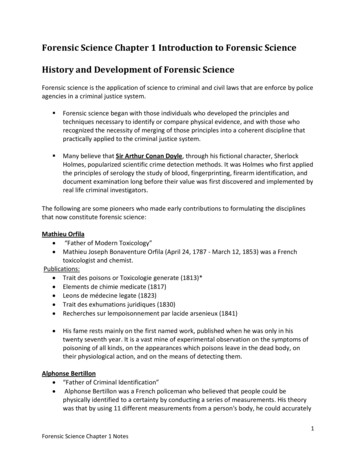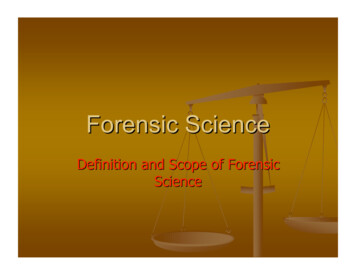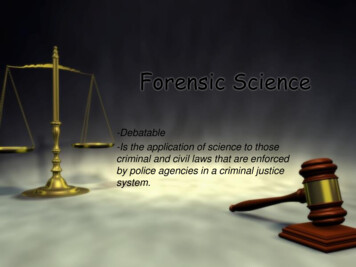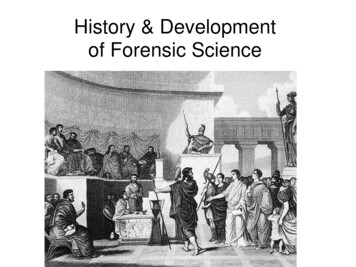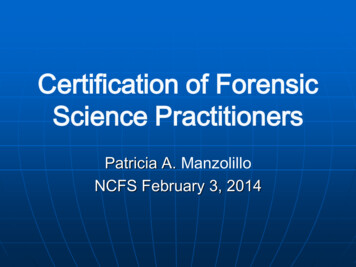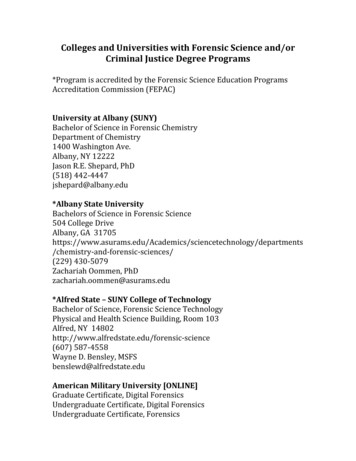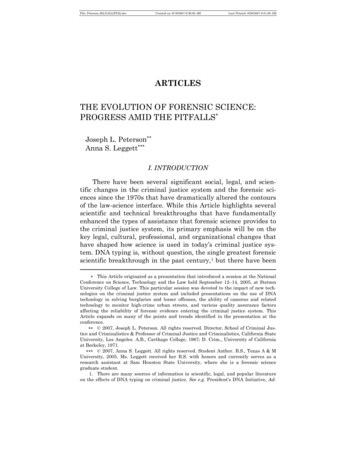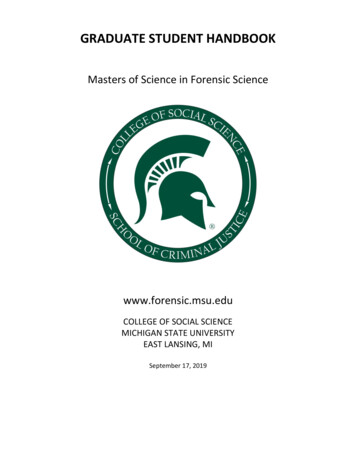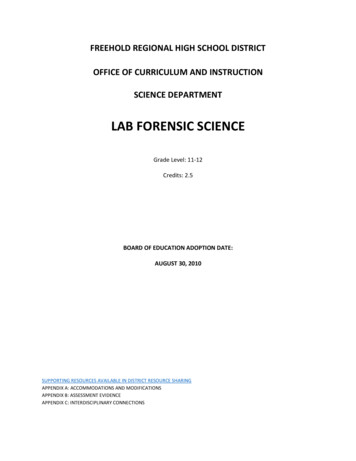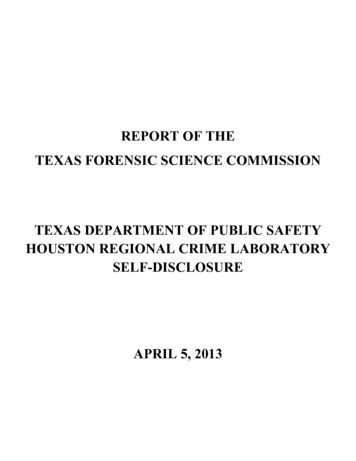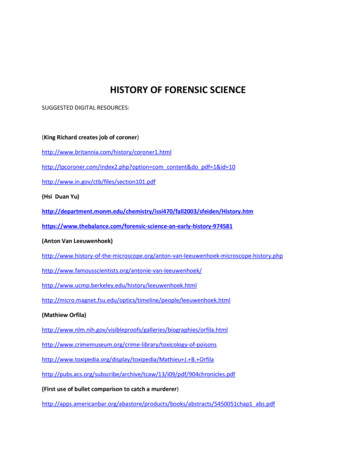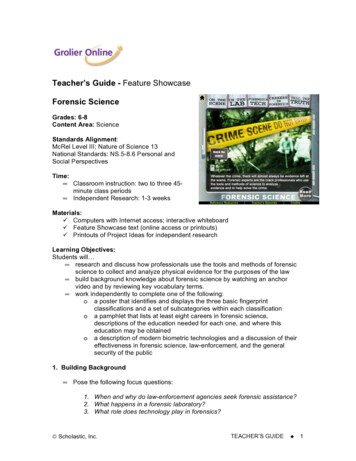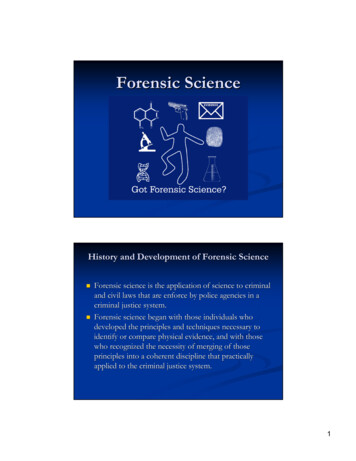
Transcription
Forensic ScienceHistory and Development of Forensic Science Forensic science is the application of science to criminaland civil laws that are enforce by police agencies in acriminal justice system.Forensic science began with those individuals whodeveloped the principles and techniques necessary toidentify or compare physical evidence, and with thosewho recognized the necessity of merging of thoseprinciples into a coherent discipline that practicallyapplied to the criminal justice system.1
1.Many believe that Sir Arthur Conan Doyle,Doyle, throughhis fictional character, Sherlock Holmes, popularizedscientific crime detection methods. It was Holmeswho first applied the principles of serology the studyof blood, fingerprinting, firearm identification, anddocument examination long before their value wasfirst discovered and implemented by real life criminalinvestigators.The following are some pioneers who made earlycontributions to formulating the disciplines thatnow constitute forensic science:2
2. Mathieu Orfila “Father of Modern Toxicology”Mathieu Joseph Bonaventure Orfila(April 24, 1787 - March 12, 1853)was a French toxicologist and chemist.Publications:Trait des poisons or Toxicologie generate (1813)*Elements de chimie medicate (1817)Leons de médecine legate (1823)Trait des exhumations juridiques (1830)Recherches sur lempoisonnement par lacide arsenieux (1841)Orfila cont’dHis fame rests mainly on the firstnamed work,published when he was only in his twentyseventh year. It is a vast mine of experimentalobservation on the symptoms of poisoning of allkinds, on the appearances which poisons leavein the dead body, on their physiological action,and on the means of detecting them.3
3. Alphonse Bertillon “Father of Criminal Identification”Alphonse Bertillon was a French policeman whobelieved that people could be physically identified to acertainty by conducting a series of measurements. Histheory was that by using 11 different measurementsfrom a person's body, he could accurately establish theiridentity at a later date. This system of identifcation isknown as Anthropometry. Today, we use photographsand fingerprints as the standard for offenderidentification (booking).Alphonse Bertillon “Fatherof CriminalIdentification”. Developed asystem ofidentification calledanthropometry.4
The areas of measurement were chosenrandomly. After discarding somemeasurements, Bertillon decided to use thebreadth of the outstretched arms, head lengthand width, left foot length, left little fingerlength, trunk height, body height, width andlength of the right ear, length of the leftforearm, and the length of the left foot.5
Bertillon also included fingerprints as part hisnew system which he called "anthropometrics".Bertillon's system became popular with lawenforcement during the 1880s. Offenders weremeasured, photographed and fingerprintedduring their booking process. However, in 1903something occurred which caused lawenforcement to discard Bertillon's system ofidentification.A Bertillon "booking" Card6
Bertillon Fingerprint CardWhat happened to Bertillon in 1903? In 1903, a prisoner by the name Will West wassentenced to incarceration at the United StatesPenitentiary at Leavenworth, Kansas. During hisinprocessing, the records clerk obtained WillWest's Bertillon measurements and photograph.Will West denied ever being incarcerated at thefacility.7
Will West's Bertillon Measurements 178.5; 187.0; 91.2; 19.7;15.8; 14.8; 6.6; 28.2;12.3; 9.7The records clerk, having referenced hisBertillon measurements into the system,retrieved the Bertillon card for a William West.Will West denied that the William West card washis. Subsequent investigation disclosed thatWilliam West had previously been incarceratedin the facility until September 9, 1901. Byexamining the photographs, one can see thefailure of the Bertillon system.8
Compare the Bertillon measurements in particular,keeping in mind the various factors that would affectthe measurements. This failure strengthened the scienceof fingerprints as the normally accepted method ofpersonal identification. The authorities compared theirfingerprints and determined that Will West was not thepreviously recorded William West. Recent opinionssuggest that Will and William West were related,therefore the closeness in measurements andappearance. As a result of this incident, Bertillon's"anthropometric" identification system was quicklydiscarded in favor of fingerprints.Will WestWilliam West9
4. Frances GaltonFrances Galton undertookthe first definitive study offingerprints as a method ofidentification. Developed amethodology of classifyingthem in 1892. His work described the basicprinciples that formed the present system ofidentification by fingerprints.Francis Galton Developed a method of classification for fingerprints.Publication: “Finger Prints” – a statistical proofof uniqueness of finger printsWrote the basic principles of the present systemof identification by finger print analysis.Cousin to Charles Darwin10
5. Leone Lattes Furthered the work of Dr Karl LandersteinerLeone Lattes discovered that blood can begrouped into different categories. Since 1915,blood types have been recognized as A, B, AB,and O.Developed a test to type dried blood that is usedfor criminal investigations.Today, his procedure is utilized often byforensic scientists.6. Calvin Goddard Bullistics – chemical analysis to tell whether agun has been fired or not.Use of a microscope to determine if a the toolmarks on a fired bullet matches a specific gun.Established the comparison microscope as anindispensible tool of the fire arms examiner.11
7. Albert S. Osborn Fundamental Principles of DocumentExamination.Book: Questioned Documents (still used today)Handwriting analysisDocument examinantionPaper examination8. Walter C. McCrone Microscope techniquesMcCrone Research Institute – Chicago ILWorld renown for microscope and microscopetrace evidence detection.Did analysis on the “Shroud of Turin”.12
9. Hans Gross Wrote the first treatise on – Application ofScience Disciplines to the Field of CriminalInvestigation.Book – Criminal Investigation: use ofmicroscope, chemistry, mineralogy, zoology,botany, and anthropometry.Forensic Journal – to report new and improvedmethods of scientific crime detection.10. Dr. Edmond LocardEstablished the first workablecrime lab. Founder and Directorof the Institute of Criminalisticsat the University of Lyons.International Center for the studyand research in forensic science.Wrote: Locards Exchange Principle13
Locards Exchange Principle Statesand believes that every criminal canbe connected to a crime scene by dustparticles carried to the crime scene, transferoccurs whenever a criminal comes intocontact with objects or a person.14
Albert S. Osborn Fundamental Principles of Document Examination. Book: Questioned Documents (still used today) Handwriting analysis Document examinantion Paper examination 8. Walter C. McCrone Microscope techniques McCrone Research Institute – Chicago IL World renown for microscope and microscope trace evidence detection. Did analysis on the “Shroud of Turin”. 13 9. Hans Gross Wrote
